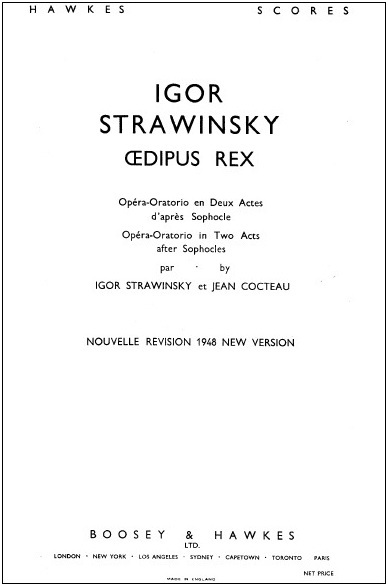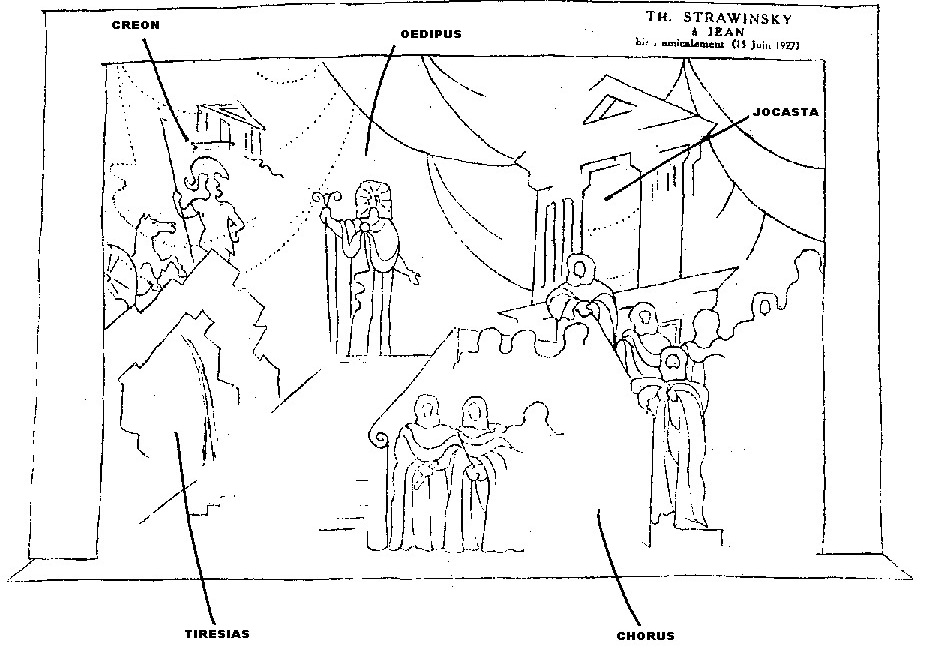Introduction
This work will describe one of Igor Stravinsky’s piece which is not the most famous one but surely interesting in a few aspects. From the form, instrumentation and libretto till the meaning in his neo-classical period works; including anti-romantic distance, ironic, return to ancient Greece (Sophocles’s tragedy).
To talk over Oedipus Rex and do it as thoroughly as possible, the author of this essay will explain Stravinsky’s life periods based on the place of residence, inspirations, style and achievements. According to his career and stylistic development there might be emerged many of the major trends in the history of 20thcentury music as nationalism, neoclassicism and serialism[1]. Some of other composer’s work will be mentioned and shortly described as an example of his life period or comparison with Oedipus Rex – main topic of this essay[2].
Biography note
Igor Fyodorovich Stravinsky is one of the most important and influent composers of the 20th century. Born in 1882 and died in 1971 as a Russian and later French (1934) and American (1945) composer, conductor and pianist. In his music may be easily noticed tendency of 20th century innovations, although he used different techniques, styles and inspirations.
Starting from neo-nationalism style of his early ballets made for Diaghilev, through neo-classicism during 1920-51, also proto-serial work in ’50 till his extremely individual interpretation of the serial method at the end of his composing period.
Stravinsky travelled around Europe what is notable in his works – especially pattern influences and allusions. However, he kept the Russian tradition in the music and attached to his new ideas[3].
The world fame came with his compositions for impresario Sergei Diaghilev and his Ballets Russes. The question might be, how did Diaghilev know about unknown Stravinsky? While leaving in Russian Empire, Stravinsky started his music career very late in compare with other composers of this time. Preferably for parents, he had to study law but since the private lessons with Rimski-Korsakov had taken place, as suggested by plausibly the leading Russian composer at that time, he (Stravinsky) united his life with music and composition.
As a result of this cooperation (Rimski-Korsakov and Stravinsky) at the beginning he wrote two orchestral works: Scherzo Fantastique and Feu d’artifice. In February 1909 in St. Petersburg both were performed and Sergei Diaghilev was present at this concert. Impresario was planning to present Russain ballets and opera in Paris. He was impressed by Feu d’artifice and asked Stravinsky to write some orchestrations and then the full-length ballet score – The Firebird.
After sensation and acceptance from audience on 25 of July 1910, he wrote two more ballets for Diaghilev. During next years he spent summer in Russia and winter in Switzerland, travelling together with his family. He worked on Petrushka and Le Sacre du printemps (The Rite of Spring). The first one had premiere in 1911 and the second piece in 1913 which was the base for audience dissatisfaction. The Rite of Springs was innovative piece for which Parisian public was not prepared yet. Nowadays it is considered as a 20th century masterpiece.
In June 1920 Stravinsky moved from Switzerland to France. In the same year, on 15 of May, took place the premiere of Pulcinella – the opening piece for neoclassical period[4].
Pulcinella is a ballet with song in one act. As an inspirations was output of Giambattista Pergolesi, made for Diaghilev wish and produced by the Russian Ballet[5].
Neoclassicism in music – short description
Neoclassicism in music goes back to the pre-romantic aesthetic, based on clarity, balance, non-emotional works. Composers looked at the classicism and 18th century music as a contrast to the late Romanticism emotionalism and formlessness. Expression was found in contrapuntal structure, rhythm and forms with the 20th century – tonal expanded – harmony, focused on absolute music, not program, which was a dominant innovation during Romantic period[6].
Main works despite the Oedipus Rex where Mavra, Octet for winds, Symphony in C, Symphony of Psalms, Apollo, Orpheus; but the culmination of neoclassicism period is in the opera The Rake’s Progress[7]. Those are principal Stravinsky’s pieces based and inspired by earlier epoch. He had influence on other composers as Darius Milhaud, Francis Poulenc and Arthur Honegger (especially his Antigone based on Sophocles’s tragedy) – members of French group – Les Six[8][9].
Short description of musical piece
All topics considered in this part will be talked over in following parts of this essay. This description is made to bring closer the main idea of Oedipus Rex, what hopefully will help to find the general context during reading and exploring this opera-oratorio.
Oedipus Rex is an opera-oratorio in two acts based on Sophocles tragedy. Music made by Igor Stravinsky, libretto by Jean Cocteau, Latin translation by Jean Danielou.
Piece is destined for tenor (Oedipus), mezzo-soprano (Jocasta), bass-baritone (Creon), bass (Tiresias), tenor (the Shepherd), bass-baritone (the Messenger), narrator, male chorus and orchestra (percussion, timpani, harp, piano and string quartet). Stravinsky worked on this piece between 11 January 1926 and 14 March 1927 in Nice.

Picture 1
The first performance was made by the Russian Ballet as an oratorio in Theatre Sarah-Bernhardt in Paris on 30th of May 1927 and was conducted by the composer. The first performance as an opera took place in Vienna one year later on 23rd of February. Duration time is circa 52 minutes[10].
Genesis of Oedipus Rex
Stravinsky in his Dialogues confided that for some years he had been aware of the need to compose a large-scale dramatic work and it took place during his mature neo-classical period, Oedipus Rex became a masterpiece of his maturity[11].
As he said in Dialogues, this opera-oratorio was composed during my strictest and most earnest period of Christian Orthodoxy. It is important to understand the narrator role correctly, well written explanation gives Walsh In this sense the narrator is a theatrical representative of that archetypal modern master, the professor of comparative religion, who now everything and believes nothing[12].
Also the language had been something special, different, to express the wisdom not in the vernacular way – he looked for older and partly sanctified language. The choice rested on Latin. As he said in Chronicle: The choice had the great advantage of giving me a medium not dead but turned to stone and so monumentalized as to have become immune form all risk of vulgarization.
The next step was the choice of subject. He turned to the ancient Greece and myths. According to his memories from Gneditch’s Russian translation of Sophocles and the impression which he got while teenage years, he decided on Oedipus Rex[13].
Libretto
In October 1925 composer turned to his friend, Jean Cocteau, and asked to write libretto for his Oedipus Rex. They knew each other before, during pre-war seasons of the Russian Ballet in Paris. Stravinsky had seen Antigone of Sophocles, for which Cocteau made libretto (for composer Arthut Honegger), and after this decided to entrust him with the libretto for Oedipus Rex. The instructions given by Stravinsky focused on non action drama, but a „still-life”. First try of Cocteau was exactly this what composer didn’t want – as Stravinsky said in Dialogues a music drama told in a horribly meretricious prose. The final draft made by Cocteau which finally met the requisites of composer has been passed to Abbe Jean Danielou, who translated it into Latin. After receiving the text in 1926, Stravinsky started to work on the music. It should be done till the twentieth anniversary of Diaghilev’s theatrical activity in 1927[14].
Speaker-narrator
Cocteau came up with the idea of Speaker. He would be a commentator who give an advance commentary on the action scene by scene in the language of audience (White 1984:329). In Oedipus Rex, the speaker-narrator plays important architecture role. First of all he draws the attention in the ritualistic nature of the drama witness. The synthesis of modern master and professor was described before in this essay by Walsh words.
The second role of narrator is bringing into play shifts in time sequence which reintroduce irony as a function of the music. By the end of each of his short speeches he has carried the story forward to its next crisis, but the music which follows must revert every time to the situation as at the start of the speech (Walsh 1988:136). The audience could keep distance from the stage spectacle, not only because of Latin as a used language for this piece, but also as an illustration of the dramatic theme. It removes the element of surprise and audience can concentrate on the purely musical progress of the score (White 1984:330).
Hybrid form
Stravinsky saw in his piece self-limiting stage concept. There is no doubt that the piece has traits of opera but also is strongly tied with oratorio. Thus as it is described by Walsh:
the statuesque dramaturgy, the pivotal structural role played by the chorus, the strict sectionalisation imposed by the narrator who in this respect resembles the Evangelist of the baroque Passion, the closed forms and rhetorical manner of the music, in which the ceremonial, the ornate, the pastoral, the pathetic and so on are treated as distinct „characters” or „modes” (Walsh 1988:139).
Characters in form of Ancient Greek drama
Stravinsky decided that there should be a minimum of action on the stage. Characters should give impression of living statues[15]. Chorus (only male) was sitting in a single row with scrolls from which they were reading but the faces were hidden under cowls. Singers were standing on elevated platforms and, except for Tiresias, Shepherd and The Messenger, the characters were in their built-up costumes and masks that only their arms and heads were able to move. During arias the singers should be illuminated (White 1984:329).
According to the main idea, characters were fixed to the positions, could express their despair only by gestures, helpless in the face of destiny. The concept was two-dimensional, singers were in the same vertical plane but at diversified heights (Walsh 1988:137).
It has own reason. Stravinsky called this piece with hybrid term of „opera-oratorio”. Composer conceived the work as an opera and wrote into the score numerous directions for its staging, it is clear he was doubtful whether it would have much chance of consolidating its position on the operatic stage: so he aimed at making it viable in the concert hall as well (White 1984:320).
Construction and tonality
Oedipus Rex consists of two acts. The predominant throughout this piece is minor mode. Stravinsky ensured the continuity of action between acts with the same chorus. Videlicet, the final chorus of Act One, is repeated at the beginning of Act Two. This overlap device was also used by Cocteau in his play „Orphee” (1926) described as a tragedy in one act and an interval (White 1984:333). The Stravinsky approved this and confess in his Dialogues: I like to go directly from tutti G major to solo flute and harp G minor. I also like to acknowledge the audience’s apprehension that the Queen Mother must have a lot to say by giving them a pause before she says it (White 1984:333). This shows how important the role of construction was for composer, even the smallest detail.
Characters have suitable tonality. Oedipus, Jocasta and Laius are mainly in minor, while chorus has diversified mode. For Oedipus the flat keys appear usually, what is described for both major and minor, as gear to the Oedipus complex. The relation with the world of normality is included in sharp keys, not flat (White 1984:334).
General idea of tonality in Oedipus Rex was described by Wilfrid Mellers: the opera is dominated by the search for D major, which is the key of the inner light; and the tonal scheme of the work has s symmetry that is simultaneously musical and doctrinal[16].
Vocal line of Oedipus have tendency towards florid decoration in the form of descending and ascending scale passages, a bit arrogant and in ostentatious style. In spite of this, it shows his promise to find the Laius’s murderer, especially in arias Ego divinabo and Invidia fortunam odit. Although to impress others and believe stronger in his activities, Oedipus repeats or imitates a phrase a semitone or a tone higher. For example after Tiresias’s accusation Rex peremptor regis est, Oedipus tries to escape from this situation by pushing the tonality up a semitone from Tiresias’s D Minor close to the E flat major, which opens the Invidia aria.
In addition to this, before the final Lux facta est the clarinet has a trill in E sharp and F sharp notes, what could be interpreted as the minor and major third of the last reached tonality of D[17].
Step back to the past
In Oedpius Rex Stravinsky summed up his achievements of neo-classical style as resemblances to passages which were in Octet and Serenade, and the contrapuntal style of accompaniment tried before in Mavra. Most of influences are not from 18th century but form 19th century Italian opera and Verdi style, for example beautiful Jocasta’s arias and the scoring of clarinets in sixths. Accompaniments are closer to Italian opera than to baroque or classical music. He also added Russian element – the Messenger and the Shepherd passages, and Oedipus Nonne monstrum based on one of Petrushka’s motifs, the Lanner waltz that accompanies the Ballerina in Scene Three of Petrushka. Finall Gloria was inspirited by Russian Church ritual[18][19].
Production and Performance
Stravinsky and Cocteau created opera-oratorio with special intention – it meant to be a gift for Diaghiev in honor of the twentieth anniversary of his theatrical activity. Diaghilev did not know about the work from the beginning, later they familiarized him with plan of opera because it meant to be presented by his company. Unlucky Diaghilev did not like the concept. To show somehow the musical piece which he did not like he conceived an idea.
As he said We’ll simply give it a concert performance – no „décor”, and the cast in evening dress, sitting on the stage in front of black velvet curtains. Musically it will even gain (White 1984:338). The original performance was in the Théâtre Sarah Bernhardt in Paris on 30 May 1927.
The project of the stage for Oedipus Rex, where characters should stay at the same place which were fixed at the beginning.

Picture 2
Vocal parts were difficult for singers and was not enough time to learn it, just because Stravinsky finished piece very late. Oedpius Rex was performed tree times in a concert form and no more. Composer said in Dialogues: when my austere vocal concert was programmed next to a very colorful ballet, the failure was greater than I had anticipated. The audience was hardly polite (White 1984:338).
After this flop it took a long time to recover. Early next year there were stage productions in Vienna and Berlin, which were not warmly accepted but better than in Paris. Other stage productions needed some time to win the acceptance as a Stravinsky’s masterpiece (White 1984:338).
New Version
In 1948 composer made a few changes in the piece. Starting from instrumentation like adding trumpet in part in Oedipus’s Nonne monstrum aria or tuba and horn in chorus Aspicite, till small rhythmic revision (White 1984:339).
Conclusion
Oedipus Rex was harshly accepted by audience in 1927. This has changed during decades. The problem was neither in inadequate form nor in innovations contended in ancient drama, made by composer. Audience’s ears were not ready to notice how magnificent in own simplicity this piece is.
Stravinsky took the best from neo-classicism and put together with 20th century harmony, mixed opera with oratorio, took care about specific language and every single break in scores – to intensify the impression. Narrator described scene by scene to let the audience follow musical progress. All the power of Oedipus Rex is based on the sound simplicity and details. That includes everything what was said before: Latin as the main language, hybrid form of opera-oratorio, „living statues„ on the stage, narrator, tonality and the topic. Thus this simply and complicated in one musical piece is something more than reflection about ancient drama in modern and neo-classical form.
Endnotes
[1] Mark McFarland, Igor Stravinsky, 2011, Oxford Bibliographies Online: Music, New York: Oxford University Press, edited by Bruce Gustavson.
[2] Stephen Walsh, Stravinsky, Igor (Fyodorovich), Grove Music Online, ed. Deane Root.
<https://www.oxfordmusiconline.com> (Accessed 10 April 2014).
[3] Ibidem.
[4] Ibidem.
[5] Eric Walter White, Stravinsky: The composer and his Works, second edition, 1984, Berkeley and Los Angeles: University of California Press.
[6] Daniel Albright, Modernism and Music: An Anthology of Sources, 2004, Chicago, University of Chicago Press.
[7] Stephen Walsh, op. cit.
[8] Benjamin Ivry, Francis Poulenc, 1996, Phaidon Press Limited.
[9] Robert Sharpio, Les Six: The French Composers and their Mentors Jean Cocteau and Erik Satie, 2011, London/Chicago, Peter Owen Publishers.
[10] Eric Walter White, op. cit.
[11] Ibidem.
[12] Stephen Walsh, The music of Stravinsky, 1988, London, Routledge.
[13] Eric Walter White, op. cit.
[14] Ibidem.
[15] A note prefixed to the score in (White 1984:329) by Cocteau.
[16] Wilfrid Mellers, Stravinsky’s Oedipus as 20th-Century Here, 1963, New York, printed in :Stravinsky: a new appraisal of his work, edited by Paul Henry Lang.
[17] Eric Walter White, op. cit.
[18] Stephen Walsh, Stravinsky…
[19] Eric Walter White, op. cit.
Bibliography
Albright Daniel, Modernism and Music: An Anthology of Sources, Chicago, 2004, University of Chicago Press.
Ivry Benjamin, Francis Poulenc, 1996, Phaidon Press Limited.
Macfarland Mark, Igor Stravinsky, 2001, Oxford Bibliographies Online: Music, New York: Oxford University Press, edited by Bruce Gustavson.
Mellers Wilfrid, Stravinsky’s Oedipus as 20th-Century Hero, 1963, New York, printed in :Stravinsky: a new appraisal of his work, edited by Paul Henry Lang.
Sharpio Robert, Les Six: The French Composers and their Mentors Jean Cocteau and Erik Satie, 2011, London/Chicago, Peter Owen Publishers.
Walsh Stephen, The music of Stravinsky, 1988, London, Routledge.
Walsh Stephen, Stravinsky, Igor (Fyodorovich), Grove Music Online, ed. Deane Root. <https://www.oxfordmusiconline.com> (Accessed 10 April 2014).
White Eric Walter, Stravinsky: The composer and his Work, 1984, Berkeley and Los Angeles: University of California Press.










